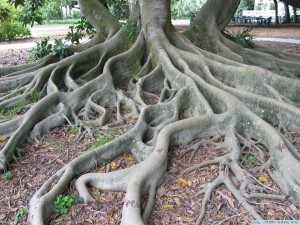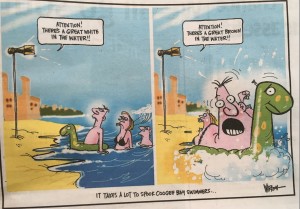Archives
Tree root Poonami closes Coogee beach
Sydney Australia has many world famous beaches. Yesterday morning, April 14th 2016, one of her crown jewels, Coogee Beach, had to be closed after a Sydney Water sewer main in nearby Dudley Street had a blockage that overflowed into the Randwick City council stormwater drains.
The blockage was caused by tree roots growing in the Sydney Water sewer main.
The overflowing sewer spilled into a stormwater pipe that discharged into the ocean, right under Coogee Surf club.
Randwick City council closed the beach and drained the Ross Jones pool next to the Coogee Surf club in the afternoon on a day when holidaying school kids and tourists alike were enjoying our beautiful autumn weather and pleasant 21 degree water temperature.

The Sydney Morning Herald reports the beach has been re-opened today after time and tide have cleaned up the beach overnight. Sydney Water technical crews were testing the water quality this morning.
The disappointing part is that this tree root blockage in the sewer pipe was totally preventable.
Cities across Australia are currently using Vaporooter to protect their sewer assets, drastically reducing maintenance costs and preventing sewer overflows like the Poonami that closed Coogee beach.
Vaporooter Helps Strata Prevent $40,000 Sewer Replacement

Location: Clovelly, Sydney
Occupants: Mostly women over 40. 2 with teenage children.
Home: Block of four 2 bedroom flats 2 up, 2 down circa 1920
Trees in Vicinity: Tree lined Street, many large Hills Weeping Fig (Ficus Microcarpa Var.)
In total we have billed this client $9,772.00 for tree root cutting and repairs.
In March 2010, they finally indicated their interest in applying Vaporooter to control the tree roots in and around their sewer pipes.
The quote to apply Vaporooter is $1,586.00. This comes with a 12-month Guarantee.
The estimated cost to renew this sewer around both sides of the building and out to the sewer main in the street is estimated to be an astonishing $40,000.00.
The roots from the trees in this street are widespread and we have attended to blocked drains in houses and unit blocks up and down the street. The roots are getting stronger and without Vaporooter, a full sewer replacement will be the only (costly) alternative.
Some of the residents have indicated that instead of applying Vaporooter, they will lobby the Council to cut down the trees. That would change the entire streetscape and severely diminish their property value above the $40,000 sewer replacement and well beyond the preventative Vaporooter solution that is guaranteed to solve the problem.
This beautiful period block of flats, a 5 minutes walk from the beach is on a street lined with Hills weeping fig trees.
You know the kind; they produce the most beautiful summer shade with birds attracted to the fruit. The branch canopy stretches right across the street. But, so does the root system of these magnificent specimens.
We were first called to this property to attend a blocked drain in May 2005. The problem was tree roots from the specimens on the public footpath at the front of the property. The ground floor flats were the worst affected. Not only did their toilets back up when they flushed them, but when the flats upstairs flushed their toilet, that also came up and sometimes overflowed in the ground floor toilets.
That’s called The U-Tube (poo-tube) effect!
We recommended to the owner occupiers that Vaporooter would control the tree roots in their sewer. They declined to take up the offer.
In the 5 years since, we have attended to this sewer blocked by tree roots 7 times. We have carried out excavations to repair sections of drainage damaged by this aggressive tree root system. This unfortunately includes costly and inconvenient weekend and after hours callouts.
Questions about Vaporooter?
No matter where you are in Australia, if you have a blocked drain caused by tree roots and you want to discuss the situation, please ring me on 1800 637 600.

Every situation with tree roots in sewer pipes is different!
If you know that tree roots are causing your blocked sewer pipes but you’re not sure Vaporooter will work in your situation, I want you to contact me personally to discuss the situation.
As a regular reader of this blog you already know there are several ways to Stop Tree Roots in Drains.
Root cutting: Makes the roots grow back Thicker and Stronger!
Pipe excavation: Damages gardens, lawns and footpaths. It is messy and can be very expensive!
Pipe relining: Its expensive!
Vaporooter will do what all these processes do …..at a fraction of the cost!
Neighbours tree roots are in my pipes
It can be quite frustrating when your neighbour has a beautiful big tree and its roots are growing under the fence between you and feasting in your sewer pipes.
In the interest of neighbourly relations it is very important to speak to the neighbours and work out a compromise on the control of the tree and its root system.
Vaporooter is a simple and effective way to stop the growth of tree roots in drains and control this persistent problem; because the tree roots will grow back after you cut them. Its just what trees do!
If your neighbour’s trees are blocking your pipes, they may be blocking the sewer pipes of the other neighbours around you. Why not find out if they’re affected and together work on a simple and cost effective drain maintenance strategy like Vaporooter.
Remember the Guarantee!
If you have a blocked drain caused by tree roots after we apply Vaporooter, we will clear your blockage for FREE!
Contact me for a copy of our Vaporooter Home Owners Guide to Tree Root control.
Why do I need a Sewer Service Diagram?
A Sewer Service Diagram, drainage diagram or “helio” (for plumbers over 30 years old) is a map that shows where the sewer pipes run throughout your home, or commercial property.
This sewer drainage diagram is available from Sydney Water, the Water authority in your capital city, a reputable plumber’s supplier or your local Council, depending on where you are in Australia!
In NSW a sewer drainage diagram is a normal inclusion in a “Contract of Sale” for your home.
The sewer diagram shows a line diagram of your property, including the boundaries of the property with the outline of the dwelling and associated buildings, with all plumbing or sanitary fixtures shown.
Whenever the sanitary or sewer drainage on a property is either modified or added to by a licensed plumber or drainer, the local water authority is booked to inspect the work and modify any existing drainage plans and upgrade the sewer diagrams of each individual property.
The sewer diagram will show if your sewer pipeline runs through other properties, if it is connected to a common sewer with multiple properties on the line and where your sewer line joins the Water Board or Municipal or Council sewer mains.
Be aware, some inner city suburbs like Paddington and Balmain have rows of terraces with up to 20 homes, and in some cases more, running through the one sewer line across the back or front of the properties.
Whenever you have a blockage in a joint or common service, it’s imperative that all parties on the common line realise that the problem is the responsibility of all parties on that common line.
That means the costs of any repairs or service to this common line should be borne by all parties on the line!
A current drainage diagram will show who is connected to the common sewer line and who isn’t.
If you have a hint of a blocked drain and you need to stop tree roots in drains, have a sewer diagram within easy reach!
Costs of this diagram will vary, dependent on the source and may range between $16 and $60.00
Council street trees and blocked sewer drains
Many of our clients say that local council street trees are the cause of their blocked sewer pipes.
Beautiful specimens like the London plane tree, Hills weeping fig (ficus microcarpa. var.) and Paperbark (melaluca) all have extensive tree root systems that thrive on the moisture and nutrients flowing through our household sewer pipes out to the sewer mains in the street.
The roots from the council trees are growing in through the pipe joints.
Some councils offer their ratepayers a drain cleaning service at “no cost” as an acceptance of responsibility for the damage caused by the council trees.
We all know there is no such thing as a free lunch………………….. or drain clean.
Ratepayers are obviously “paying” for this service through their quarterly levies and at some point these local councils will put rates up or put the responsibility of drain maintenance back on the ratepayers.
Many homeowners, upon finding out council trees are blocking their pipes, insist they will lobby the council to cut down these beautiful trees to stop their invasive roots from blocking the sewer pipes. I have seen council street trees cut down because they continue to block the sewer pipes of the nearby homes.
So who wins here? Beautiful tree lined streets are raped by a chainsaw gang.
Not to mention the dramatic de-valuation of the homes that have had the street trees removed.
In one comical instance, the beautiful (but invasive) tree that was removed by the chainsaws and 4 weeks after the stump grinder churned through, was replaced by a junior version the same species. Now call me crazy……
So, I’ve got another idea!
If you’re one of these ratepayers with drains affected by council trees, next time you get a blockage and the council plumber clears your blockage for free, look for your local Vaporooter applicator to do a Drainoscopy of your sewer pipes.
If it’s suitable, have him apply Vaporooter to your pipeline.
You will be amazed with the results.
Vaporooter Stops Tree Roots in Drains!
All ratepayers keep their council trees, the council saves your money, you maintain the value of your home and still have a free flowing pipe system!
Win Win Win Win
Why we need a plan of your sewer pipes
Generally, when sewer pipes and drains are installed by a licensed plumber, they are inspected by an authorised person who draws a plan of the drainage installation showing where the drains run, what plumbing fixtures are connected and what, if any, other properties are connected.
Currently, we have a self inspection system where the plumber draws the drainage installation and submits the drawing to the local water authority or council for their records.
Owners can get a copy of this diagram from their local water authority or council. If your property has a history of blocked drains or is surrounded by trees, I strongly suggest you have a copy of this drainage diagram and keep it in a safe and easily accessible place.
Your local plumber can assist with getting a copy of this drainage diagram.
In NSW Australia, a drainage diagram is a standard inclusion in a Contract of Sale for any property. I suggest you look there first!
Who is responsible for these drains?
Problems with drains, including blockages, occur no matter what type of building you live in.
Most single or multiple level houses have their own drainage systems taking the discharge from all the plumbing fixtures within the property. The owner of the property is responsible for the maintenance and upkeep of their pipes up to the point where his pipes join the council main.
Rows of terrace houses in inner city suburbs and semi-detached homes often drain into a “common sewer line”. These terrace rows can have up to 20 homes or more, draining into one common line. Depending on the fall of the land, this common sewer line may pass across the front or rear of the row and then spill into a Boundary trap, before discharging into the Water authority’s main sewer line.
Generally, the common sewer line should be maintained by the owners of the properties connected to the sewer line, and costs associated with works or repairs on this common sewer line should be borne by all parties on that common sewer line.
If blockages, repairs or pipe renewals are confined to the pipes and drains that take the discharge from any one particular house on the common sewer line, then those costs should be borne by that individual.
Any property owners connected to a common sewer line should be aware that should a blockage occur in the common line, downstream of where he/she connects to the line, the sewer may surcharge or overflow in his/her yard or garden if it is the lowest open drain in the line.
This can be quite unpleasant if someone else’s sewer is coming up in your yard or even worse, your home!
When blockages occur, we recommend that all owners connected to a common sewer line communicate and co-operate with all other parties on this line .
Strata home unit blocks and Townhouses will have their own drainage lines that generally drain to a Boundary trap and then on to the Water Authority or Council sewer mains.
The responsibility for the maintenance and repairs of these drains is generally directed by a Strata Title Manager and sometimes a Real Estate Property Manager.
Commercial properties, Industrial Estates and Schools generally all have their own drainage lines that generally drain to a Boundary trap and then on to the Water Authority or Council sewer mains.
The First Sign Of A Tree Root Blockage
The first sign of a tree root blockage is a slow drain. Simple right? But, this won’t be an average slow drain that can be cured with a plunger or a drain cleaning solution. The blockage may be accompanied by a gurgling sound from within the drain, which can be heard when no water is running.
A quick visual diagnosis will let you know if there is a tree root blockage. Any trees that are within 60 meters of the building, or within ten meters of any known pipes, have root systems that might penetrate a line.
Tree roots are more likely to grow into your lines during winter and other cold months. That’s because tree roots have to travel farther for moisture during these months. Older pipes, especially those laid before the 1980s, can be made of materials that are easy for tree roots to infiltrate.
Some plumbers use high-tech cameras to determine whether a blockage is common, or caused by a tree root system. A camera is attached to a drain snake and run down the affected pipe so that the tech savvy blockage experts can use this camera to explore every aspect of a blocked pipe. They’ll take a video, diagnose the problem, and then suggest the best course of action.

